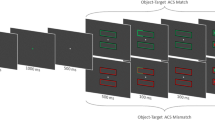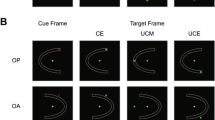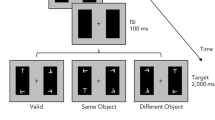Abstract
Evidence for object-based attention typically comes from studies using displays with visible objects, and little is known about whether object-based attention can occur with invisible objects. We investigated this issue with a modified double-rectangle cuing paradigm, which was originally developed by Egly et al. (J Exp Psychol Gen 123:161–177, 1994). In this study, low-contrast rectangles were presented very briefly, which rendered them invisible to subjects. With the invisible rectangles, we found a classical object-based attentional effect as indexed by the same-object effect. We also found the instantaneous object effect—object-based attention was dependent on the orientation of the rectangles presented with the target, providing evidence for the dynamic updating hypothesis (Ho and Yeh in Acta Psychol 132:31–39, 2009). These results suggest that object-based attention can be guided by an invisible object in an automatic way, with a minimal influence from high-level top-down control.





Similar content being viewed by others
References
Abrams RA, Law MB (2000) Object-based visual attention with endogenous orienting. Percept Psychophys 62:818–833
Albrecht AR, List A, Robertson LC (2008) Attentional selection and the representation of holes and objects. J Vis 8(13):8, 1–10
Almeida J, Mahon BZ, Nakayama K, Caramazza A (2008) Unconscious processing dissociates along categorical lines. Proc Natl Acad Sci USA 105:15214–15218
Astle DE, Nobre AC, Scerif G (2010) Subliminally presented and stored objects capture attention. J Neurosci 30(10):3567–3571
Bahrami B, Lavie N, Rees G (2007) Attentional load modulates responses of human primary visual cortex to invisible stimuli. Curr Biol 17:509–513
Behrmann M, Zemel R, Mozer M (1998) Object-based attention and occlusion: evidence from normal subjects and a computational model. J Exp Psychol Hum Percept Perform 24:1011–1036
Brefczynski JA, DeYoe EA (1999) A physiological correlate of the “spotlight” of visual attention. Nat Neurosci 2:370–374
Brown JM, Denney HI (2007) Shifting attention into and out of objects: evaluating the processes underlying the object advantage. Percept Psychophys 69:606–618
Chou WL, Yeh SL (2012) Object-based attention occurs regardless of object awareness. Psychon Bull Rev 19(2):225–231
Dehaene S et al (2001) Cerebral mechanisms of word masking and unconscious repetition priming. Nat Neurosci 4:752–758
Egly R, Driver J, Rafal RD (1994) Shifting visual attention between objects and locations: evidence from normal and parietal lesion subjects. J Exp Psychol Gen 123:161–177
Enns JT, Austen EL, Di Lollo V, Rauschenberger R, Yantis S (2001) New objects dominate luminance transients in attentional capture. J Exp Psychol Hum Percept Perform 27:1287–1302
Eriksen CW, Yeh YY (1985) Allocation of attention in the visual field. J Exp Psychol Hum Percept Perform 5:583–597
Fang F, He S (2005) Cortical responses to invisible objects in human dorsal and ventral pathways. Nat Neurosci 8(10):1380–1385
Franconeri SL, Simons DJ (2003) Moving and looming stimuli capture attention. Percept Psychophys 65:999–1010
Goldsmith M, Yeari M (2003) Modulation of object-based attention by spatial focus under endogenous and exogenous orienting. J Exp Psychol Hum Percept Perform 29:897–918
Ho MC, Yeh SL (2009) Effects of instantaneous object input and past experience on object-based attention. Acta Psychol 132:31–39
Jiang Y, He S (2006) Cortical responses to invisible faces: dissociating subsystems for facial-information processing. Curr Biol 16:2023–2029
Jiang Y, Costello P, Fang F, Huang M, He S (2006) A gender-and sexual orientation-dependent spatial attentional effect of invisible images. Proc Natl Acad Sci USA 103:17048–17052
Kanai R, Tsuchiya N, Verstraten FA (2006) The scope and limits of top-down attention in unconscious visual processing. Curr Biol 16:2332–2336
Kastner S, Pinsk MA, De Weerd P, Desimone R, Ungerleider LG (1999) Increased activity in human visual cortex during directed attention in the absence of visual stimulation. Neuron 22:751–761
Koch C, Tsuchiya N (2006) Attention and consciousness: two distinct brain processes. Trends Cogn Sci 11:16–22
Koch C, Tsuchiya N (2012) Attention and consciousness: related yet different. Trends Cogn Sci 16:103–105
Kouider S, Eger E, Dolan R, Henson RN (2009) Activity in face-responsive brain regions is modulated by invisible, attended faces: evidence from masked priming. Cereb Cortex 19:13–23
Lamy D, Tsal Y (2000) Object features, object locations, and object files: which does selective attention activate and when? J Exp Psychol Hum Percept Perform 26:1387–1400
Leopold DA, Logothetis NK (1996) Activity changes in early visual cortex reflect monkeys’ percepts during binocular rivalry. Nature 379:549–553
Li FF, VanRullen R, Koch C, Perona P (2002) Rapid natural scene categorization in the near absence of attention. Proc Natl Acad Sci USA 99:9596–9601
Liu T, Larsson J, Carrasco M (2007) Feature-based attention modulates orientation selective responses in human visual cortex. Neuron 55:313–323
Marino AC, Scholl BJ (2005) The role of closure in defining the “objects” of object-based attention. Percept Psychophys 67:1140–1149
Maunsell JH, Treue S (2006) Feature-based attention in visual cortex. Trends Neurosci 29:317–322
McMains SA, Somers DC (2004) Multiple spotlights of attentional selection in human visual cortex. Neuron 42:677–686
Melcher D, Papathomas TV, Vidnyanszky Z (2005) Implicit attentional selection of bound visual features. Neuron 46:723–729
Moore CM, Fulton C (2005) The spread of attention to hidden portions of occluded surfaces. Psychon Bull Rev 12:301–306
Moore CM, Yantis S, Vaughn B (1998) Object-based visual selection: evidence from perceptual completion. Psychol Sci 9:104–110
Mulckhuyse M, Talsma D, Theeuwes J (2007) Grabbing attention without knowing: automatic capture of attention by subliminal spatial cues. Vis Cogn 15:779–788
Müller NG, Kleinschmidt A (2003) Dynamic interaction of object- and space-based attention in retinotopic visual areas. J Neurosci 23:9812–9816
Naccache L, Blandin E, Dehaene S (2002) Unconscious masked priming depends on temporal attention. Psychol Sci 13:416–424
O’Craven K, Downing P, Kanwisher N (1999) fMRI evidence for objects as the units of attentional selection. Nature 401:584–587
Pilz KS, Roggeveen AB, Creighton SE, Bennett PJ, Sekuler AB (2012) How prevalent is object-based attention? PLoS ONE 7(2):e30693
Posner MI, Snyder CR, Davidson BJ (1980) Attention and the detection of signals. J Exp Psychol 109:160–174
Pratt J, Sekuler AB (2001) The effects of occlusion and past experience on the allocation of object-based attention. Psychon Bull Rev 8:721–727
Richard AM, Lee H, Vecera SP (2008) Attentional spreading in object-based attention. J Exp Psychol Hum Percept Perform 34:842–853
Saenz M, Buracas GT, Boynton GM (2002) Global effects of feature-based attention in human visual cortex. Nat Neurosci 5:631–632
Scholl BJ (2001) Objects and attention: the state of the art. Cognition 80:1–46
Serences JT, Boynton GM (2007) Feature-based attentional modulations in the absence of direct visual stimulation. Neuron 55:301–312
Shomstein S, Behrmann M (2006) Cortical systems mediating visual attention to both objects and spatial locations. Proc Natl Acad Sci USA 130:11387–11392
Treue S, Martinez-Trujillo JC (1999) Feature-based attention influences motion processing gain in macaque visual cortex. Nature 399:575–579
Tsuchiya N, Koch C (2005) Continuous flash suppression reduces negative afterimages. Nat Neurosci 8:1096–1101
Vecera SP, Farah MJ (1994) Does visual attention select objects or locations? J Exp Psychol General 123:146–160
Watanabe M et al (2011) Attention but not awareness modulates the BOLD signal in the human V1 during binocular suppression. Science 334:829–831
Watson SE, Kramer AF (1999) Object-based visual selective attention and perceptual organization. Percept Psychophys 61:31–49
Weber TA, Kramer AF, Miller GA (1997) Selective processing of superimposed objects: an electrophysiological analysis of object-based attentional selection. Biol Psychol 45:159–182
Yang E, Zald DH, Blake R (2007) Fearful expressions gain preferential access to awareness during continuous flash suppression. Emotion 7:882–886
Yantis S (1993) Stimulus-driven attentional capture and attentional control settings. J Exp Psychol Hum Percept Perform 19:676–681
Zhang W, Luck SJ (2009) Feature-based attention modulates feedforward visual processing. Nat Neurosci 12:24–25
Zhang X, Zhaoping L, Zhou T, Fang F (2012) Neural activities in V1 create a bottom-up saliency map. Neuron 73:183–192
Acknowledgments
This work was supported by the National Natural Science Foundation of China (Project 91024032, 30925014 and 90920012) and the Ministry of Science and Technology of China (2011CBA00405 and 2010CB833903).
Author information
Authors and Affiliations
Corresponding author
Rights and permissions
About this article
Cite this article
Zhang, X., Fang, F. Object-based attention guided by an invisible object. Exp Brain Res 223, 397–404 (2012). https://doi.org/10.1007/s00221-012-3268-4
Received:
Accepted:
Published:
Issue Date:
DOI: https://doi.org/10.1007/s00221-012-3268-4




